
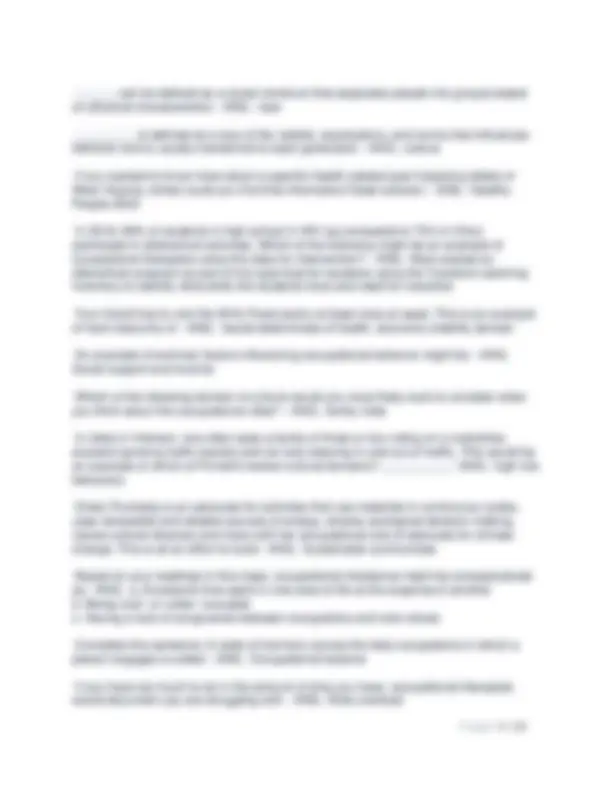
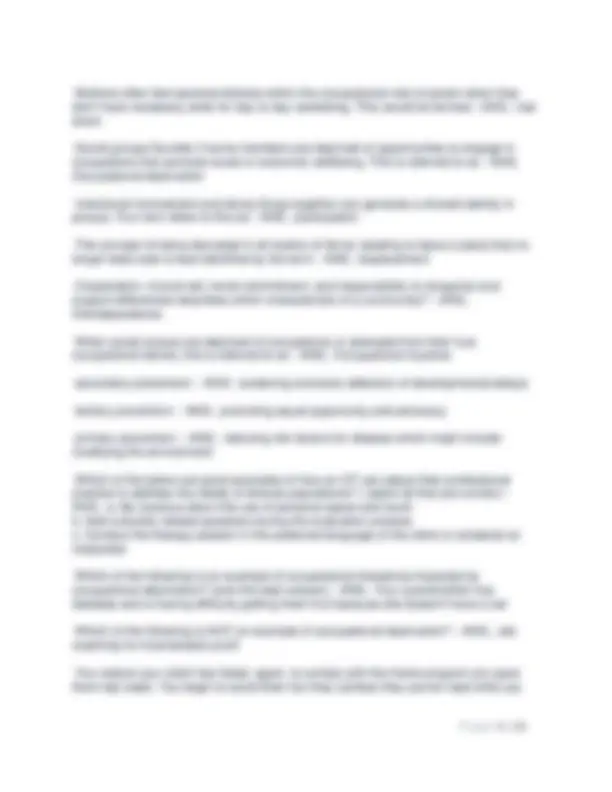
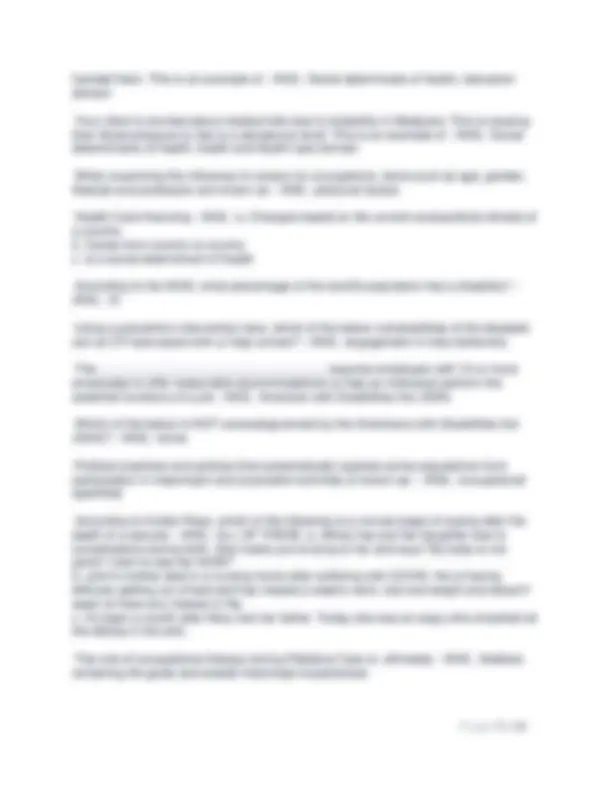
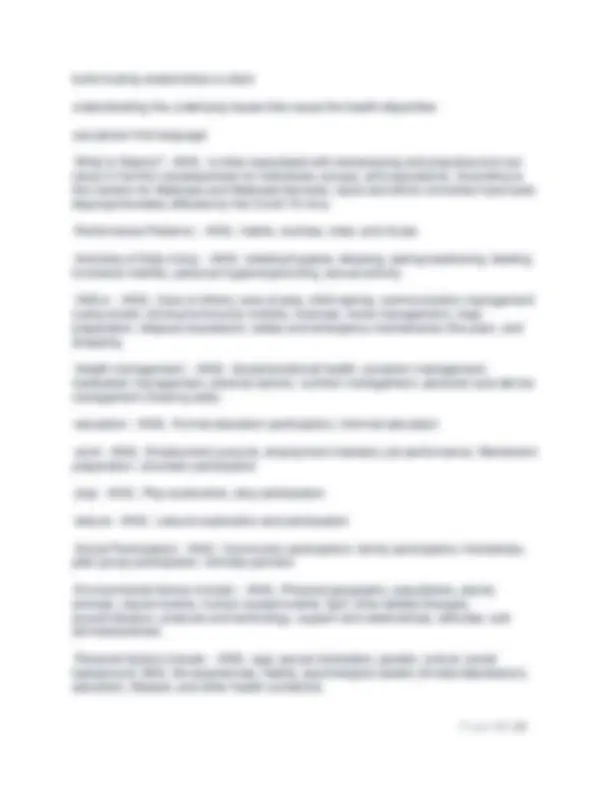

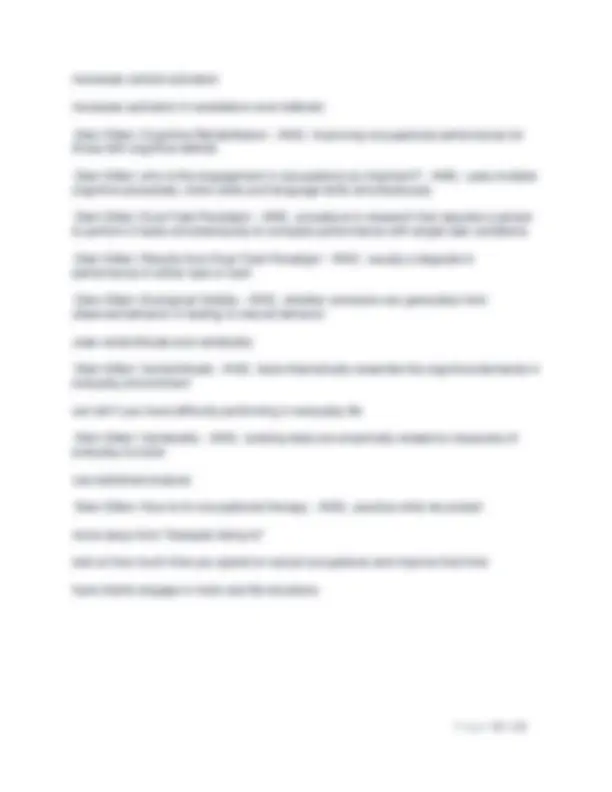


Study with the several resources on Docsity

Earn points by helping other students or get them with a premium plan


Prepare for your exams
Study with the several resources on Docsity

Earn points to download
Earn points by helping other students or get them with a premium plan
Community
Ask the community for help and clear up your study doubts
Discover the best universities in your country according to Docsity users
Free resources
Download our free guides on studying techniques, anxiety management strategies, and thesis advice from Docsity tutors
Various concepts and definitions related to occupational science and therapy. Topics include occupational performance, occupational balance, health, performance patterns, core values in occupational therapy, and social determinants of health. The document also discusses the peo model, culture, and occupational imbalance.
Typology: Exams
1 / 10

This page cannot be seen from the preview
Don't miss anything!







By their nature, occupations are actively engaging, purposeful and meaningful. - ANS; true This thought leader is credited with coining the phrase "occupational science". - ANS; Elizabeth Yerxa All Occupational Therapists are Occupational Scientists? - ANS; false Which of the below definitions is NOT true about occupational science? - ANS; Occupational science belongs only to the occupational therapy field Human actions in response to an occupational form is best described as - ANS; occupational performance ________________ are relatively automatic, specific, repetitive patterns of human behavior. - ANS; Habits ___________ are defined as habitual, repeatable and predictable ways of acting that provide a structure for living. - ANS; Routines A ____________________ is a culturally defined pattern of occupation that reflects particular routines and habits. - ANS; role Being relatively happy or satisfied with the ability to perform one's desired occupations within the constraints of the day is a good definition of: - ANS; occupational balance "A state of complete mental, physical, and social well-being and not merely the absence of disease" is the definition of: - ANS; Health Definitions of occupation by occupational scientists have all the following ideas in common EXCEPT - ANS; Occupations are viewed equally Habits, Routines, Rituals and Roles are classified by the OTPF as - ANS; Performance patterns Jane had a stroke and has weakness in her left hand. Her goal is to eventually be able to pick up her grandchild. The occupational therapist decides to spend a session having Jane mix up a batter for cookies. This is an example of using : - ANS; occupation as a Means
When people, the physical space, time and objects interconnect refers to: - ANS; transactional process The core values in occupational therapy's philosophical axiology include considering all of the following EXCEPT: - ANS; Goals developed by the OT practitioner Which of the following is a core assumption of occupational therapy? - ANS; Human beings are occupational in nature Two part question: 1. Select an occupation that is an important to you from the AOTA framework (1 pt) 2. For EACH of the four performance patterns - describe how the occupation might be influenced or affected by the pattern ( 2 points) - ANS; framework and class Which of the following is a NOT an example of a necessary occupation? - ANS; Making a latte for your customer at Starbucks Which one of the following would be the best example of co-occupation? - ANS; Two sisters working together to make dinner for the family Capacities refers to a person's potential for occupation. Which of the below is true about capacities? - ANS; ALL OF THE ABOVE a. capacities are age and gender specific b. capacities are shaped by genetics c. capacities develop as one ages and grows Which of the below ideas led to the founding of occupational therapy? (YOU MAY SELECT MULTIPLE ANSWERS ) - ANS; a. Active engagement can help with nervous disorders b. Work was a better cure than rest c. Industrialization and immigration created mental health problems that existing treatments could not fix The OT profession was initially rooted in mental health. During what time frame did the profession expand into physical rehab? - ANS; 1920- 1939 When did school based therapy services for disabled children become law? - ANS; 1960 - 1979 Which time period in OT history resulted in developments in prosthetics and assistive technology? - ANS; 1940- 1959 Which OT began the discussion of neurobehavioral related OT, eventually developing into the sensory integration theory? - ANS; Jean Ayres The PEO model stands for - ANS; Person, environment, and occupation
Mothers often feel parental distress within the occupational role of parent when they don't have necessary skills for day to day caretaking. This would be termed - ANS; role strain Social groups flounder if some members are deprived of opportunities to engage in occupations that promote social or economic wellbeing. This is referred to as - ANS; Occupational deprivation Intentional involvement and doing things together can generate a shared identity in groups. Your text refers to this as - ANS; participation The concept of being disrupted in all realms of life by needing to leave a place that no longer feels safe is best identified by the term - ANS; displacement Cooperation, mutual aid, moral commitment, and responsibility to recognize and support differences describes which characteristic of a community? - ANS; Interdependence When social groups are deprived of occupations or alienated from their true occupational selves, this is referred to as - ANS; Occupational injustice secondary prevention: - ANS; screening and early detection of developmental delays tertiary prevention: - ANS; promoting equal opportunity and advocacy primary prevention: - ANS; reducing risk factors for disease which might include modifying the environment Which of the below are good examples of how an OT can adjust their professional practice to address the needs of diverse populations? ( select all that are correct) - ANS; a. Be cautious about the use of personal space and touch b. Add culturally related questions during the evaluation process c. Conduct the therapy session in the preferred language of the client or schedule an interpreter Which of the following is an example of occupational imbalance impacted by occupational deprivation? (pick the best answer) - ANS; Your grandmother has diabetes and is having difficulty getting fresh fruit because she doesnt't have a car. Which of the following is NOT an example of occupational deprivation? - ANS; Job coaching for incarcerated youth You realize your client has failed, again, to comply with the home program you gave them last week. You begin to scold them but they confess they cannot read what you
handed them. This is an example of - ANS; Social determinate of health, education domain Your client is worried about medical bills due to instability in Medicare. This is causing their blood pressure to rise to a dangerous level. This is an example of - ANS; Social determinants of health, health and health care domain When examining the influence of context on occupations, items such as age, gender, lifestyle and profession are known as - ANS; personal factors Health Care financing - ANS; a. Changes based on the current sociopolitical climate of a country b. Varies from country to country c. Is a social determinant of health According to the WHO, what percentage of the world's population has a disability? - ANS; 15 Using a prevention intervention lens, which of the below vulnerabilities of the disabled can an OT best assist with or help correct? - ANS; engagement in risky behaviors The __________________________________ requires employers with 15 or more employees to offer reasonable accommodations to help an individual perform the essential functions of a job - ANS; American with Disabilities Act (ADA) Which of the below is NOT covered/governed by the Americans with Disabilities Act (ADA)? - ANS; home Political practices and policies that systematically oppress some populations from participation in meaningful and purposeful activities is known as: - ANS; occupational apartheid According to Kubler-Ross, which of the following is a normal stage of coping after the death of a spouse: - ANS; ALL OF THESE. a. Mindy has lost her daughter due to complications during birth. She insists you're lying to her and says "My baby is not gone! I want to see her NOW!" b. John's mother died in a nursing home after suffering with COVID. He is having difficulty getting out of bed and has missed a week's work, has lost weight and doesn't' seem to have any interest in life. c. It's been a month after Mary lost her father. Today she was so angry she smashed all the dishes in the sink. The role of occupational therapy during Palliative Care is, ultimately - ANS; Address remaining life goals and enable meaningful experiences
One of the articles you read was Hollywood takes on intellectual disability (IDD). What is the major concerning finding of the article? - ANS; Hollywood portrayal of those with IDD perpetuates society's division of normal vs abnormal I am an OT. Once I have completed the occupational profile for a client, I might wish to use various assessments to help measure occupational performance. I would complete assessments as part of which stage of the OT process: - ANS; Evaluation Mary says she is satisfied with her sense of self, health and Socioeconomic status. She would be describing her - ANS; quality of life OTs need to learn and use theory in practice because: - ANS; ALL OF THESE. a. Helps identify our competence and identity b. Provides common foundation for all OT professionals c. Justifies reimbursement The first steps of theory development include all of the following except - ANS; Proving it is valid and reliable The experiences of inequity from being outside the dominant or mainstream discourse and events of everyday occupations. Being invisible, silent is known as - ANS; Occupational marginalization Which of the below is an example of the concept of designing environments for interdependence or universal design? (could be more than 1) - ANS; a. Large push buttons besides doors that automatically open the door b. Hands free paper towel dispenser You have a sedentary client who wishes to start an exercise program to reduce her risk of a stroke. The best model for you to use while helping her through the process of making exercise a regular part of her life would be: - ANS; Transtheoretical model of change If I am working with a client who has decreased strength in her hand, but really wants to be able to cook a meal for her spouse, what would be an excellent occupation centered goal to set for the client? - ANS; Susan will be able to independently open and close ten spice jars What is Implicit Bias? - ANS; attitudes or stereotypes that affect our understanding, actions, and decisions in an unconscious manner What does Implicit Bias lead to? - ANS; health disparities How to Address Implicit Bias - ANS; increase our understanding of values, norms, beliefs, attitudes and behaviors within different cultures
build trusting relationships w client understanding the underlying issues that cause the health disparities use person first language What is Stigma? - ANS; is often associated with stereotyping and prejudice and can result in harmful consequences for individuals, groups, and populations. According to the Centers for Medicare and Medicaid Services, racial and ethnic minorities have been disproportionately affected by the Covid-19 virus Performance Patterns: - ANS; habits, routines, roles, and rituals Activities of Daily living: - ANS; toileting/hygiene, dressing, eating/swallowing, feeding, functional mobility, personal hygiene/grooming, sexual activity. IADLs: - ANS; Care of others, care of pets, child rearing, communication management (using email), driving/community mobility, finances, home management, meal preparation, religious expression, safety and emergency maintenance (fire plan), and shopping. Health management: - ANS; Social/emotional health, symptom management, medication management, physical activity, nutrition management, personal care device management (hearing aids). education - ANS; Formal education participation, Informal education work - ANS; Employment pursuits, employment interests, job performance, Retirement preparation, volunteer participation play - ANS; Play exploration, play participation leisure - ANS; Leisure exploration and participation Social Participation - ANS; Community participation, family participation, friendships, peer group participation, intimate partners Environmental factors include: - ANS; Physical geography, populations, plants, animals, natural events, human caused events, light, time-related changes, sound/vibration, products and technology, support and relationships, attitudes, and services/policies. Personal factors include: - ANS; age, sexual orientation, gender, culture, social background, SES, life experiences, Habits, psychological assets (Anxiety/depression), education, lifestyle, and other health conditions.
increases cortical activation increases activation in cerebellum and midbrain Glen Gillen: Cognitive Rehabilitation - ANS; improving occupational performance for those with cognitive deficits Glen Gillen: why is the engagement in occupations so important? - ANS; uses multiple cognitive processes, motor skills and language skills simultaneously Glen Gillen: Dual-Task Paradigm - ANS; procedure in research that requires a person to perform 2 tasks simultaneously to compare performance with single-task conditions Glen Gillen: Results from Dual-Task Paradigm - ANS; usually a degrade in performance in either task or both Glen Gillen: Ecological Validity - ANS; whether someone can generalize from observed behavior in testing to natural behavior uses verisimilitude and veridicality Glen Gillen: Verisimilitude - ANS; tests theoretically resemble the cognitive demands in everyday environment can tell if you have difficulty performing in everyday life Glen Gillen: Veridicality - ANS; existing tests are empirically related to measures of everyday function use statistical analysis Glen Gillen: How to fix occupational therapy - ANS; practice what we preach move away from "therapist doing to" look at how much time you spend on actual occupations and improve that time have clients engage in more real life situations